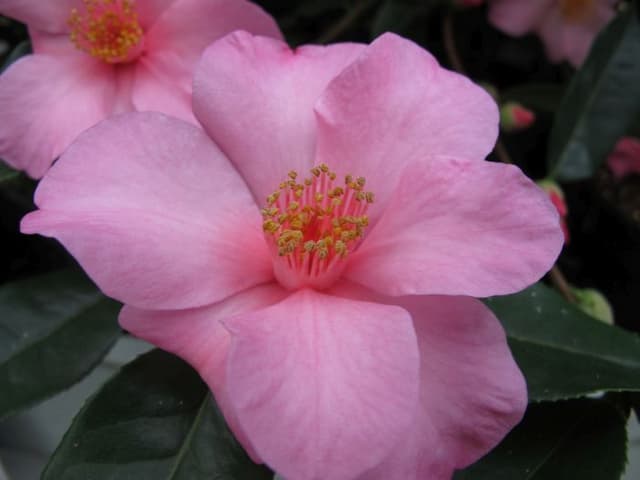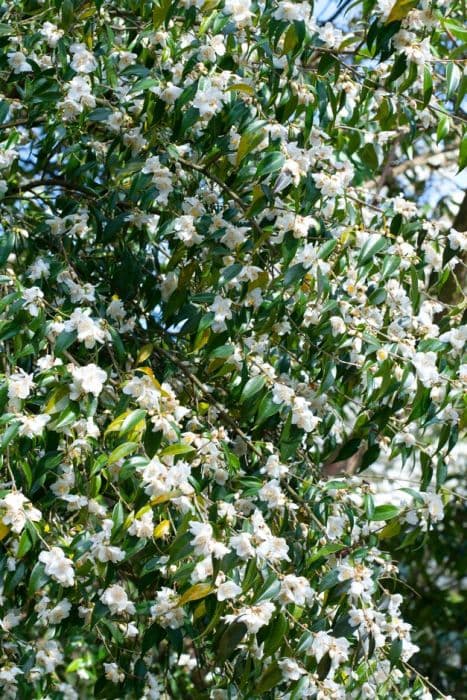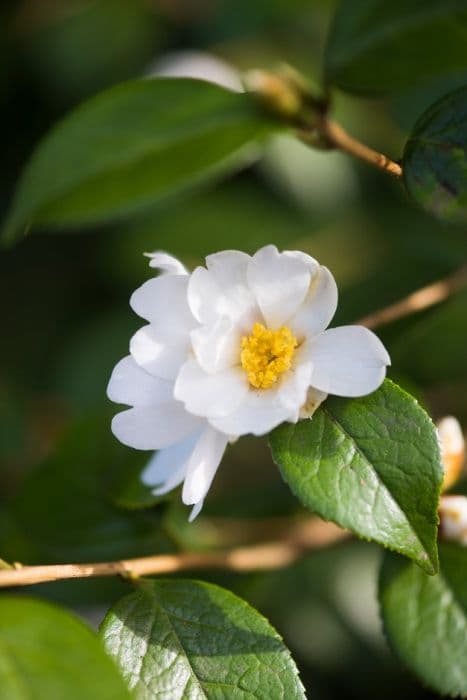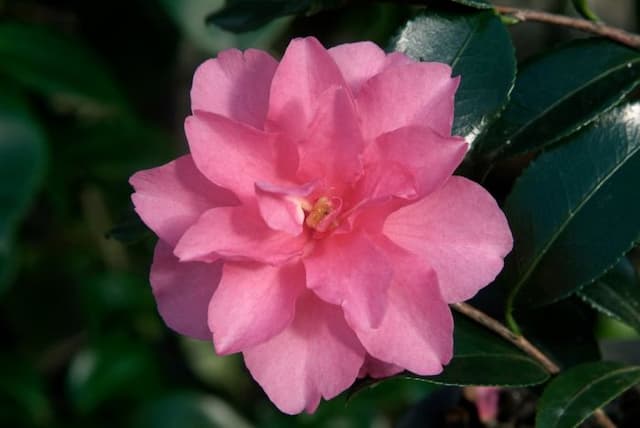Japanese Camellia Camellia 'Snow Flurry'

ABOUT
The Camellia 'Snow Flurry' boasts an elegant and showy appearance, characterized by its abundant and striking white flowers. These blossoms are large and lush, often resembling a frothy cascade of snow-white petals layered one upon another in a classic rosette form. They are held against a backdrop of glossy, deep green leaves that contrast beautifully with the pureness of the flowers, giving the plant a vibrant, fresh look. The leaves themselves have a leathery texture and are oval-shaped with slightly serrated edges, which add to the overall lushness of the foliage. When in full bloom, the 'Snow Flurry' presents a breathtakingly beautiful sight, with the white flowers standing out dramatically against the greenery. Although aspects such as the exact dimensions of the plant are not discussed, it is worth noting that the overall form of the Camellia 'Snow Flurry' is typically well-balanced and neatly rounded. This gives it an appearance of being a well-structured plant, suitable for refined garden settings or as a specimen in landscape designs where its ornamental value can be fully appreciated. Its notable bloom season adds a sense of anticipation and visual delight to the garden, as the plant transforms with the arrival of its snowy blossoms.
About this plant
 Names
NamesFamily
Theaceae
Synonyms
Snow Flurry Camellia, Winter's Snowman Camellia
Common names
Camellia 'Snow Flurry'.
 Toxicity
ToxicityTo humans
The Camellia 'Snow Flurry', commonly referred to as the camellia, is not considered highly toxic to humans. However, ingestion in large quantities could potentially cause minor digestive discomfort. There is no widespread documentation of serious poisoning from ingesting camellias in humans, but it is generally recommended to avoid eating parts of ornamental plants due to the potential for mild stomach upset.
To pets
The Camellia 'Snow Flurry', commonly known as the camellia, is also not considered highly toxic to pets. Like with humans, ingestion of camellia leaves or flowers by pets could lead to mild gastrointestinal upset, including symptoms such as vomiting or diarrhea. Even though severe toxicity is rare, it is still advisable to prevent pets from ingesting plant material, particularly in significant amounts, to avoid any potential discomfort or complications.
 Characteristics
CharacteristicsLife cycle
Perennials
Foliage type
Evergreen
Color of leaves
Green
Flower color
White
Height
5-10 feet (1.5-3 meters)
Spread
5-10 feet (1.5-3 meters)
Plant type
Shrub
Hardiness zones
6-9
Native area
Asia
Benefits
 General Benefits
General Benefits- Ornamental Appeal: The Camellia 'Snow Flurry' features a profusion of white flowers that can add a decorative touch to gardens and landscapes.
- Winter Blooms: It is known for its ability to bloom during the cooler months, often when few other plants are flowering, providing color and interest in winter gardens.
- Evergreen Foliage: This plant maintains its glossy, green leaves year-round, which keeps gardens looking lush even when other plants have lost their leaves.
- Shade Tolerance: Camellia 'Snow Flurry' can thrive in partially shaded conditions, making it suitable for planting under tree canopies or in other less sunny spots.
- Drought Tolerance: Once established, it has a degree of drought tolerance, reducing the need for frequent watering.
- Versatile Landscaping: It can be used in various landscape designs, including as a specimen plant, in mixed borders, or as part of a hedge or screening.
- Attracts Pollinators: The flowers can attract pollinators like bees, which are necessary for the health of the garden ecosystem.
- Resilience to Pests: This plant shows resistance to many pests, reducing the need for chemical treatments.
 Medical Properties
Medical PropertiesThis plant is not used for medical purposes.
 Air-purifying Qualities
Air-purifying QualitiesThis plant is not specifically known for air purifying qualities.
 Other Uses
Other Uses- Photography Subject: The 'Snow Flurry' camellia, with its distinctive white flowers, can provide a captivating subject for photographers, especially when seeking images that convey tranquility or the beauty of winter flora.
- Bonsai Practice: Some enthusiasts use Camellia 'Snow Flurry' for bonsai due to its attractive bloom and foliage, making it a unique choice for this traditional Japanese art form.
- Literary Inspiration: Writers and poets may be inspired by the beauty of this camellia to include floral imagery and metaphors in their work, using it as a symbol for purity or a serene natural scene.
- Artistic Reference: Artists can use Camellia 'Snow Flurry' as a reference for painting and drawing, capturing its white blooms and glossy leaves in various forms of visual art.
- Culinary Presentation: Though not for consumption, the blooms of Camellia 'Snow Flurry' can be used as a delicate and beautiful garnish for plating high-end culinary dishes.
- Educational Tool: Botany educators may use Camellia 'Snow Flurry' as a living example when teaching about the camellia genus or the evolution of plant adaptations in different climates.
- Fabric Designs: The patterns of Camellia 'Snow Flurry' flowers can inspire textile designs for fabric prints in fashion and home decor, lending a touch of elegance and nature-inspired patterns.
- Wedding Decor: The white flowers of the Camellia 'Snow Flurry' make it ideal for winter weddings, providing a natural snowy ambiance to the event's floral arrangements.
- Thematic Events: The 'Snow Flurry' can be featured in garden shows or thematic events that focus on winter-flowering plants, celebrating the diversity of plants that bloom in colder seasons.
- Scented Products: While typically not used for its scent, the subtle fragrance of Camellia 'Snow Flurry' can inspire the creation of candles, perfumes, or other scented products that aim to capture the essence of a winter garden.
Interesting Facts
 Feng Shui
Feng ShuiThe Camellia is not used in Feng Shui practice.
 Zodiac Sign Compitability
Zodiac Sign CompitabilityThe Camellia is not used in astrology practice.
 Plant Symbolism
Plant Symbolism- Admiration - Camellias are often symbols of admiration and are given to express the giver's positive feelings about someone's qualities.
- Perfection - With its perfect petals and lush presentation, the camellia represents the ideal of perfection and excellence.
- Love - In some cultures, camellias are associated with love, particularly the devoted love of one person for another.
- Longevity - The hardiness and longevity of the camellia bush can symbolize the wish for a long and healthy life.
- Deep Desire - The richness of the camellia's flowers can signify a deep-seated desire or passion.
- Affection - Camellias can represent the sentiment of longing or affection towards someone, particularly in a context where such feelings are appropriate.
- Faithfulness - Given that camellias can bloom for a considerable span of time, they often symbolize faithfulness and commitment that endures.
- Gratitude - A camellia can be a gift of gratitude, expressing thanks for someone's actions or presence in one's life.
 Water
WaterThe Snow Flurry Camellia prefers consistent moisture and should be watered thoroughly once a week, ensuring the soil is moist but not waterlogged. During hot, dry spells, increase watering frequency to twice a week. Provide about 1 to 1.5 gallons of water per watering session, allowing the water to seep deeply into the soil to encourage root growth. Be cautious not to overwater as this can lead to root rot. Adjust the amount based on rainfall and check the top few inches of soil for dryness as a guide.
 Light
LightThe Snow Flurry Camellia thrives in partial shade to dappled sunlight. It's best positioned where it can be protected from the harsh afternoon sun, which can scorch its leaves. A spot with morning sunlight and afternoon shade or filtered light throughout the day is ideal to promote healthy growth and flowering.
 Temperature
TemperatureThe Snow Flurry Camellia is hardy and can tolerate temperatures as low as 10°F and as high as 100°F, but it grows best in a range of 50°F to 80°F. It should be sheltered from strong, cold winter winds and extreme heat. Proper mulching can help to maintain a stable root temperature.
 Pruning
PruningPruning the Snow Flurry Camellia is generally done to shape the plant, remove dead or weak wood, and promote more vigorous growth. The best time to prune is just after blooming finishes in late winter or early spring. It should be pruned lightly and selectively to maintain a natural form, and it's not necessary to prune it every year unless shaping is desired or to remove damaged branches.
 Cleaning
CleaningAs needed
 Soil
SoilThe ideal soil mix for Camellia 'Snow Flurry' should be well-draining and rich in organic matter, with a pH between 5.5 and 6.5. A mixture of 1/3 pine bark, 1/3 peat moss, and 1/3 perlite or sand can work well for these camellias to ensure proper drainage and acidity.
 Repotting
RepottingCamellia 'Snow Flurry' should be repotted every 2-3 years, in spring before the growth season or after flowering. It is essential not to damage the delicate roots during repotting and to use appropriate soil mix as described.
 Humidity & Misting
Humidity & MistingCamellia 'Snow Flurry' prefers a humid environment, with the best humidity level ranging between 40-60%. These conditions can be especially important during the dry indoor heating season to prevent bud drop.
 Suitable locations
Suitable locationsIndoor
Keep in a bright spot, avoid direct sun, and ensure high humidity for Camellia 'Snow Flurry'.
Outdoor
Plant in partial shade, sheltered from intense afternoon sun and drying winds.
Hardiness zone
7-9 USDA
 Life cycle
Life cycleThe Camellia 'Snow Flurry' starts its life cycle when its seeds germinate, which requires warm, well-draining soil and may take several weeks to months. After germination, the seedling stage begins and continues until the plant has formed a rosette of leaves and is strong enough to be transplanted. The vegetative stage follows, characterized by the development of stems, leaves, and the root system; during this period, the plant focuses on growth rather than reproduction. As it matures, the camellia enters the flowering stage, typically in late autumn to winter, when its large white, fluffy flowers bloom, attracting pollinators for reproduction. Following pollination, the plant produces seed pods that will eventually dry and release seeds, completing the reproductive cycle. Over many years, the camellia can grow into a large shrub or a small tree and will continue this life cycle annually, with proper care and environmental conditions.
 Propogation
PropogationPropogation time
Early spring
Camellia 'Snow Flurry', commonly known as a type of Camellia, is most commonly propagated through semi-hardwood cuttings. The best time to take these cuttings is in late summer to early fall, when the new growth has begun to mature and harden slightly. To propagate by cuttings, one should select a healthy stem, cut a 4 to 6-inch (10 to 15 cm) length, and strip the leaves from the lower half of the cutting. The cut end is then dipped in rooting hormone to encourage root development and placed in a pot filled with a mixture of peat and perlite or a well-draining potting mix. The cutting should be kept moist and in a warm, indirect light until roots have formed, which typically takes several weeks to a few months.









